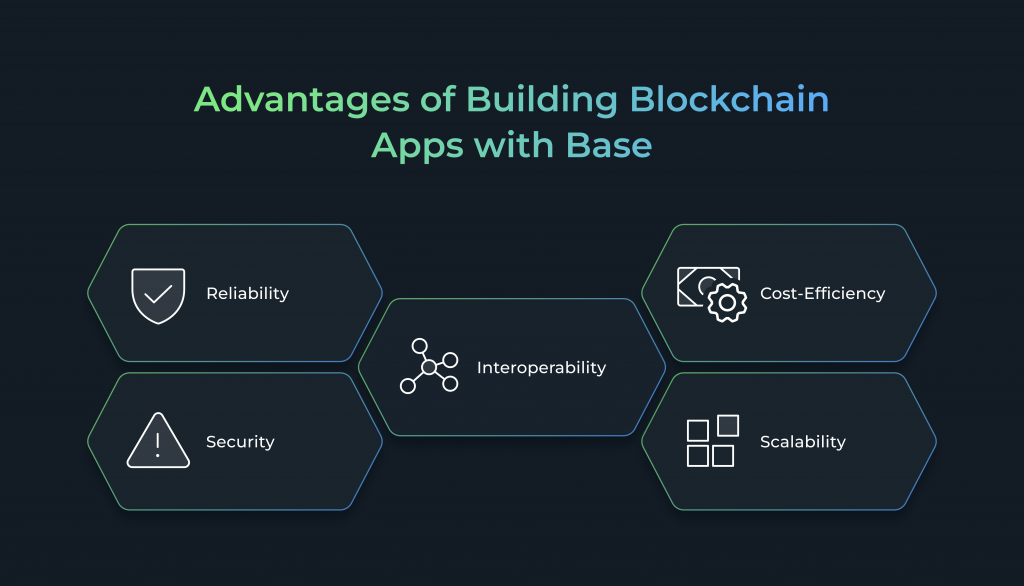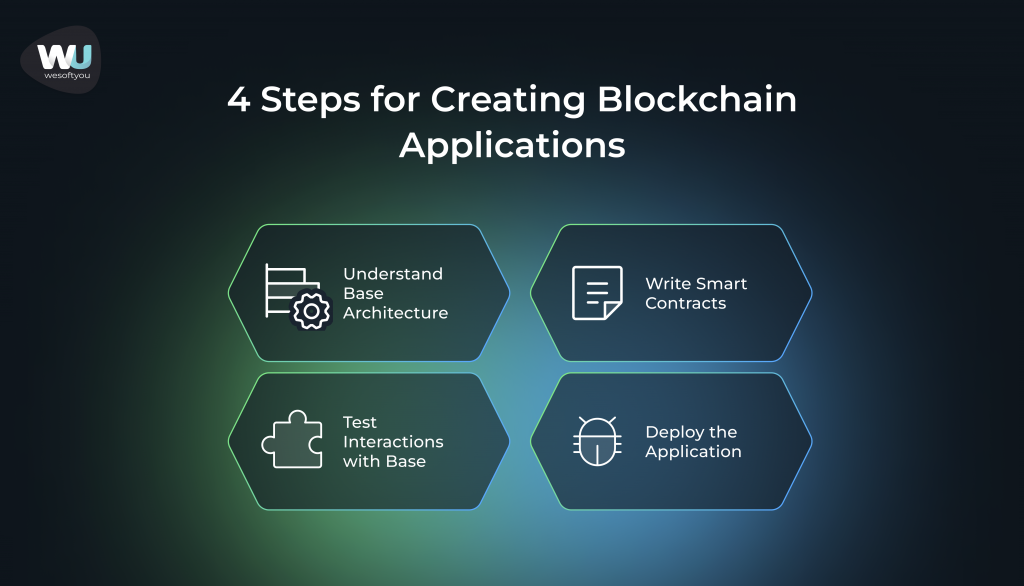Coinbase is one of the most prominent and widely used cryptocurrency exchanges in the world. Founded in 2012, it allows users to buy, sell, and store various cryptocurrencies like Bitcoin and Ethereum.
Ethereum’s blockchain has struggled with issues such as high fees, slow transaction processing times, and limitations in scalability. The need for a solution to address these challenges has led to the development of Layer-2 solutions. Base Coinbase is a Layer-2 solution that offers a cost-effective, scalable, and efficient platform for deploying decentralized applications (dApps) on the Ethereum network.
As a blockchain solutions developer, WeSoftYou wants to share expertise in this article. You’ll know the technical aspects of Base, its benefits, software types, and their typical applications.
What Is Base?
Base is an Ethereum Layer 2 (L2) blockchain officially released on August 9, 2023, by Coinbase. Rollups like Base are designed to help Layer 1 (L1) blockchains, such as Ethereum, scale. They bundle multiple transactions into a single submission on the Ethereum mainnet, reducing gas fees for users.
Base allows developers to build decentralized applications (DApps) with access to Coinbase’s vast ecosystem. This includes over 110 million verified users and more than $80 billion in assets.
Base is Ethereum Virtual Machine (EVM) compatible. It means developers can seamlessly deploy their EVM codebase from Ethereum and other compatible chains to Base.
A Technical Overview of Coinbase’s Base
Base Coinbase offers a fresh approach to addressing Ethereum’s scalability issues. Let’s dive into its technical overview:
Built Using OP Stack
Base is built using the OP Stack, an open-source modular framework developed by Optimism. The OP Stack enables different Layer 2 networks within the Ethereum ecosystem to communicate and share resources effectively.
The Optimism’s OP Stack decouples the functions of a blockchain and assembles them into modules through APIs. It enhances flexibility and adaptability, as developers can choose the necessary components to suit their specific use cases.
It’s important to note that Base is subject to changes and upgrades introduced by the Optimism Collective, enhancing the overall performance and functionality. However, they also introduce potential bugs, cyberattack vectors, and malfunctions in the Base network.
Tokenless Architecture
In a traditional blockchain or Layer 1 (L1) network, a native cryptocurrency (often a token or coin) plays a central role in the network’s operations. However, Base does not introduce a new network token. Instead, it leverages Ethereum’s existing Ether (ETH) for transaction fees and operations.
A tokenless blockchain architecture simplifies the user experience, eliminating the need to handle a new and potentially complex cryptocurrency. It reduces speculative risks, as users are shielded from price volatility and trading associated with new tokens. Also, such architecture enhances security by mitigating the risks of scams related to new token issuance.
Commitment to Decentralization
Base acknowledges the crypto community’s concerns about centralization. Coinbase is the exclusive sequencer node responsible for processing transactions on Base. The sequencer plays a crucial role in the roll-up technology by recording and reporting transactions and crediting funds to users’ accounts.
Coinbase has mentioned the possibility of third-party node integration in the future while reserving the right to charge and modify associated fees.
Supports Account Abstraction
Account abstraction uses smart contract wallets instead of Externally Owned Accounts (EOAs). Users are no longer required to own the native asset (in this case, ETH) to pay for transaction fees. Additionally, it enables the recovery of wallets using email addresses.
The partnership with Gelato and Safe to use an SDK for account abstraction underlines Base’s dedication to introducing these innovations. It offers significantly lower transaction fees than the Ethereum mainnet. Additionally, dApps developers can streamline development, eliminating the need to accommodate legacy EOA accounts.
Why Choose Base for Your Blockchain App Development?

Choosing Base for your blockchain app development offers several compelling advantages:
Reliability
Base is designed to provide a stable and consistent development environment for building decentralized applications. The rules and protocols governing the blockchain are consistent and predictable.
Also, Base is expected to have minimal downtime and to be accessible to users and developers when they need it. High availability ensures that DApps can operate smoothly and without interruptions.
Security
Coinbase, a well-established and reputable cryptocurrency exchange, has had to uphold high-security standards to protect user assets and maintain trust. This expertise is leveraged to enhance the security of on-chain products within the Base ecosystem.
Security encompasses not only the technology itself but also the development practices and processes. This includes best coding, auditing, and continuous monitoring practices to ensure the platform remains resilient to vulnerabilities and attacks.
Interoperability
Traditional cryptocurrencies often operate in isolated silos, making transferring assets or data between these silos complex and cumbersome. Coinbase Base chain aims to eliminate these barriers, serving as a bridge that connects DApps and assets on its Layer 2 (L2) network. This broader ecosystem includes Ethereum’s Layer 1 (L1) and other Layer 2 solutions.
Users and developers can leverage the benefits of different blockchains and networks while still operating within the Base ecosystem. This seamless interaction reduces friction and opens up new possibilities for cross-chain applications.
Cost-Efficiency
Gas fees on the Ethereum mainnet (L1) have become a significant concern. Base solves this problem by providing a low-cost Layer 2 (L2) alternative. Transaction fees on Base consist of two components: L2 execution fee and L1 security fee.
At the same time, porting Ethereum-compatible apps to Base is easy with minimal changes.
High data compression also means much lower costs than Ethereum. As a result, developers and users find Base a cost-effective platform for their blockchain needs.
Scalability
Base leverages OP Stack chains, part of the Optimistic Rollup (ORU) technology, to enhance the scalability. Optimistic Rollup is a Coinbase L2 scaling solution designed to process transactions more efficiently while maintaining high security. While Ethereum’s mainnet typically processes around 15 transactions per second (TPS), Base aims to hold up to 2000 TPS.
One of the key drivers of scalability is the improvement in compression techniques. They allow for more efficient data processing, reducing the size and complexity of transactions. This results in a more streamlined and scalable network.
What Type of Apps Can You Build With Coinbase’s L2 Network?
You can build a wide range of blockchain apps on Coinbase’s L2 network, including the following:
Base Decentralized Application (DApp)
A Base DApp is a blockchain-based decentralized application that is typically designed to operate in a trustless, secure, and transparent manner. It takes advantage of Base’s unique features, including its scalability, cost-efficiency, and interoperability.
Base DApps can encompass a wide range of use cases:
- Financial services. They include offering decentralized lending and borrowing platforms, decentralized exchanges (DEXs), and yield farming applications. Individuals can benefit from DeFi services by earning interest on their assets, trading cryptocurrencies, and accessing lending options with lower fees.
- Gaming platforms. Gamers can enjoy fair games and own in-game assets as non-fungible tokens (NFTs). Developers create games with reduced transaction costs and improved scalability, enhancing the gaming experience.
Base Multichain Application
A Base multichain application is an enterprise solution engineered to leverage the multichain features of the Coinbase Layer 2 blockchain. It facilitates seamless communication and data sharing across multiple blockchain networks.
And this is how businesses in supply chain and logistics can use it:
- Tracking goods and materials across various blockchain networks
- Verifying the authenticity and ethical sourcing of products
- Managing assets and payments across multiple platforms seamlessly
- Maintaining the integrity of supply chain data, reducing fraud, and enhancing data privacy and security
- Automating processes like compliance checks, settlements, and verifications
Base On-Chain Contract
A Base on-chain contract application operates on the Base Layer 2 blockchain and focuses on the management and execution of legal contracts. These contracts are stored immutably on the blockchain, ensuring transparency, security, and tamper-proof records.
Base on-chain contract applications offer a range of features for businesses, such as:
- Legal sector. Base on-chain contract apps offer legal professionals a secure platform for creating, verifying, and executing smart contracts. Sensitive legal documents are protected from unauthorized access and tampering. Also, legal firms can reduce operational costs by eliminating intermediaries and automating contract execution.
- Real estate. Such companies store property information, ownership records, and transaction history on the blockchain, reducing fraud and ensuring data integrity. Buyers and sellers save on fees and administrative costs associated with traditional real estate transactions.
Base Web3 Platform
A Base Web3 platform provides a framework for creating, sharing, and engaging with content while giving users data ownership. It offers a range of features designed to enhance the user experience and promote trust and transparency.
Let’s discuss its use cases for content creators and social networking platforms:
- Producing and distributing content in a decentralized and censorship-resistant environment
- Exploring monetization options, including direct payments, donations, and NFT-based content sales
- Expressing themselves freely without fear of content removal or restrictions
- Getting transparent and trustworthy metrics and analytics
- Adding community governance, including content moderation, policy changes, and feature development
Base Identity Management Solution
A Base identity management solution is a blockchain-based application that prioritizes the secure and private administration of sensitive user data. It offers robust features for identity management, privacy, and security.
The Base identity management solution holds significant potential for the healthcare and government sectors. Here’s how:
- Healthcare. Such solutions offer secure and private management of highly sensitive patient data, safeguarding patient privacy and confidentiality. Ensure that data handling meets legal and industry standards. Also, healthcare professionals can efficiently access patient records, improving the quality of care and reducing administrative burden.
- Government. Governments also deal with vast amounts of citizen information for various services and records. Guarantee data secure and private management, keeping it transparent and accountable. At the same time, organizations can streamline services and reduce bureaucracy by securely managing and accessing citizen records and interactions.
4 Steps to Build Blockchain Applications on Base

Building blockchain applications on Base involves a systematic process that requires four key steps:
#1 Understand Base Architecture
To start, you should delve into the details of the OP Stack, the foundational framework on which Base is built.
The OP Stack is an open-source modular framework developed by Optimism, and it plays a critical role in the architecture of Base. Understand the different layers and components within the OP Stack, including the Data Availability Layer, Derivation Layer, Execution Layer, and Settlement Layer. This understanding is crucial for creating applications that seamlessly interact with Base.
#2 Write Smart Contracts
Next, you’ll need to develop smart contracts for your application.
Base is EVM-compatible, so it supports smart contracts written in Ethereum’s Solidity language. You can also utilize Truffle, Hardhat, or other Ethereum development frameworks you know.
Ensure your smart contracts conform to the standards and capabilities of Base, keeping in mind that the development environment is similar to Ethereum.
#3 Test Interactions with Base
Extensive testing is essential before deploying your application on Base. Utilize tools such as Truffle, Hardhat, or other Ethereum-compatible testing frameworks to simulate and evaluate your application’s behavior. They will help you identify and resolve any issues or bugs in your smart contracts and interactions with Base.
Interact with Base through its APIs, which enable you to test and validate your application’s functionality. The Base API allows you to send and receive transactions, query data, and monitor the status of your application on the Base blockchain. Testing your application’s interactions with Base using these APIs ensures it functions as intended.
#4 Deploy the Application
Once your application has been thoroughly tested and is free of any issues, it’s time to deploy it on Base. Follow the deployment procedures outlined by Base and Optimism to ensure a smooth and successful process. These procedures will involve submitting your smart contracts to the Base blockchain, configuring your application’s settings, and initiating its operation on the network.
During deployment, it’s crucial to adhere to best practices to optimize the performance and security of your application on Base. They may include setting appropriate gas fees, configuring DeFi security measures, and efficiently deploying smart contracts.
Why Partner with Us for Your Base App?
WeSoftYou is a trusted blockchain software development company offering a strong foundation for your next application. Our specialists provide services like blockchain consultation, requirement planning, product design, and building. They are skilled in Ethereum, EVM-based blockchains, and Tezos and can work with all the related programming languages and frameworks.
Our team can help your business with blockchain solutions, including decentralized apps (dApps), Web3 platforms, NFT marketplaces, smart contracts, and crypto trading systems. And here are some of our cases:
NDAX
NDAX is a Canadian cryptocurrency exchange platform for secure trading closely linked with the country’s banking system. The project focused on delivering speedy ID verification, the lowest fees in Canada, a wide range of coins, and around-the-clock customer support.
We’ve designed NDAX to work seamlessly on various devices, making it easy and safe for users to trade cryptocurrencies. Also, we were committed to security, including encryption, two-factor authentication (2FA), and adherence to Canada’s top security standards.
GoodDollar
GoodDollar is an eToro blockchain-powered project. It uses blockchain and decentralized finance for greater financial inclusion. The project operates to establish a basic standard of living and reduce wealth inequality by introducing a universal basic income (UBI).
We’ve made the platform compatible with popular cryptocurrency wallets and incorporated 4+ marketing analytics tools for understanding user behavior and engagement. Users can keep track of their account balances, transactions, and UBI distribution through a real-time dashboard. Additionally, they can benefit from a personalized invitation referral system.
Wrapping Up
Coinbase Base represents an exciting opportunity in blockchain and cryptocurrency. It offers a scalable, efficient, and cost-effective solution for decentralized app development.
With a focus on security, interoperability, and identity management, Base promises to unlock new possibilities for a wide range of industries. It offers a foundation for innovative applications and greater accessibility within the crypto ecosystem.
Contact us if you need assistance with blockchain app development or want to know its approximate cost.
FAQs
Base is a Layer 2 (L2) blockchain solution developed by Coinbase, a well-known cryptocurrency exchange. It’s designed to address some of the scalability and cost-efficiency challenges faced by the Ethereum blockchain. Base is built using the OP Stack, an open-source framework developed by Optimism.
Base can be used across various industries and sectors, offering a versatile and scalable platform for various applications. In particular, you can create decentralized applications for finance and gaming, multichain applications for supply chain and logistics, on-chain contract applications for the legal sector and real estate, Web3 platform for content creators and social networks, or identity management solutions for healthcare and government.
Yes, Coinbase has introduced a Layer 2 (L2) solution known as Base. Officially released on August 9, 2023, it has gained attention in the crypto community for being the first blockchain launched by a publicly traded company.





















